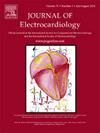Exploring artificial intelligence methods for cardiac syncope diagnosis combined with electrocardiogram parameters and clinical characteristics
IF 1.3
4区 医学
Q3 CARDIAC & CARDIOVASCULAR SYSTEMS
引用次数: 0
Abstract
Background
Cardiac syncope can be life-threatening, but there is no clinical tool for initial screening. The study explored and developed optimal artificial intelligence methods for automatic diagnosis of cardiac syncope based on combinations of electrocardiogram parameters and clinical characteristics.
Methods
The patients presenting with syncope and hospitalized between June 21, 2018 and August 23, 2022 at the Second Hospital of Tianjin Medical University. The patients enrolled were divided into development cohort who were then randomly split into a training set and an internal validation set (4: 1) and temporal validation cohort. Fifteen features of syncope patients were ranked and valuable features were selected. Six supervised machine learning models were developed to explore a potential prediction model for cardiac syncope. The area under the curve (AUC) was the primary metric used to evaluate classification performance.
Results
A total of 380 patients (340 in the development cohort and 40 in the temporal validation cohort) were included in the final analysis. The random forest showed the best performance using the top twelve features ranked by importance, demonstrating an AUC of 0.85 (sensitivity: 0.72, specificity: 0.85, F1 score: 0.74) in the development cohort, and an AUC of 0.75 (sensitivity: 0.70, specificity: 0.65, F1 score: 0.68) in the validation cohort. The novel approach for automatic diagnosis of cardiac syncope has been proposed as web service for further application.
Conclusions
Artificial intelligence methods may assist in syncope classification, and which have the potential to serve as a cost-effective and efficient screening tool for cardiac syncope.

探索人工智能方法结合心电图参数及临床特点诊断心源性晕厥
背景:心源性晕厥可能危及生命,但没有临床工具进行初步筛查。本研究探索并开发了基于心电图参数与临床特征相结合的心脏性晕厥自动诊断的最佳人工智能方法。方法选取天津医科大学第二医院2018年6月21日至2022年8月23日住院的晕厥患者。入组患者分为发展队列,发展队列随机分为训练组、内部验证组(4:1)和时间验证组。对晕厥患者的15个特征进行排序,选出有价值的特征。开发了六个监督机器学习模型,以探索心脏性晕厥的潜在预测模型。曲线下面积(AUC)是评价分类效果的主要指标。结果共纳入380例患者(开发组340例,时间验证组40例)。随机森林在使用按重要性排序的前12个特征时表现最佳,在发展队列中显示AUC为0.85(灵敏度:0.72,特异性:0.85,F1评分:0.74),在验证队列中显示AUC为0.75(灵敏度:0.70,特异性:0.65,F1评分:0.68)。提出了一种新的心源性晕厥自动诊断方法——web服务,以供进一步应用。结论人工智能方法可辅助晕厥分类,有望成为一种经济有效的心源性晕厥筛查工具。
本文章由计算机程序翻译,如有差异,请以英文原文为准。
求助全文
约1分钟内获得全文
求助全文
来源期刊

Journal of electrocardiology
医学-心血管系统
CiteScore
2.70
自引率
7.70%
发文量
152
审稿时长
38 days
期刊介绍:
The Journal of Electrocardiology is devoted exclusively to clinical and experimental studies of the electrical activities of the heart. It seeks to contribute significantly to the accuracy of diagnosis and prognosis and the effective treatment, prevention, or delay of heart disease. Editorial contents include electrocardiography, vectorcardiography, arrhythmias, membrane action potential, cardiac pacing, monitoring defibrillation, instrumentation, drug effects, and computer applications.
 求助内容:
求助内容: 应助结果提醒方式:
应助结果提醒方式:


